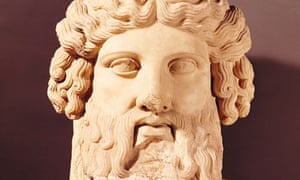Plato's stave: academic cracks philosopher's musical code
Historian claims Plato's manuscripts are mathematically ordered according to 12-note scale
 The research appears to support a previously discredited symbolic, rather than literal, way of reading Plato's great works. Photograph: Greek/Getty Images/The Bridgeman Art Library
The research appears to support a previously discredited symbolic, rather than literal, way of reading Plato's great works. Photograph: Greek/Getty Images/The Bridgeman Art LibraryJulian Baggini
Tuesday 29 June 2010 14.21 BSTLast modified on Tuesday 3 June 201411.20 BST
Share on Pinterest
Share on LinkedIn
Share on Google+
Shares
809
Save for later
It may sound like the plot of a Dan Brown novel, but an academic at the University of Manchester claims to have cracked a mathematical and musical code in the works of Plato.
Jay Kennedy, a historian and philosopher of science, described his findings as "like opening a tomb and discovering new works by Plato."
Plato is revealed to be a Pythagorean who understood the basic structure of the universe to be mathematical, anticipating the scientific revolution of Galileo and Newton by 2,000 years.
Kennedy's breakthrough, published in the journal Apeiron this week, is based on stichometry: the measure of ancient texts by standard line lengths. Kennedy used a computer to restore the most accurate contemporary versions of Plato's manuscripts to their original form, which would consist of lines of 35 characters, with no spaces or punctuation. What he found was that within a margin of error of just one or two percent, many of Plato's dialogues had line lengths based on round multiples of twelve hundred.
The Apology has 1,200 lines; the Protagoras, Cratylus, Philebus and Symposium each have 2,400 lines; the Gorgias 3,600; the Republic 12,200; and the Laws 14,400.
Kennedy argues that this is no accident. "We know that scribes were paid by the number of lines, library catalogues had the total number of lines, so everyone was counting lines," he said. He believes that Plato was organising his texts according to a 12-note musical scale, attributed to Pythagoras, which he certainly knew about.
"My claim," says Kennedy, "is that Plato used that technology of line counting to keep track of where he was in his text and to embed symbolic passages at regular intervals." Knowing how he did so "unlocks the gate to the labyrinth of symbolic messages in Plato".
Believing that this pattern corresponds to the 12-note musical scale widely used by Pythagoreans, Kennedy divided the texts into equal 12ths and found that "significant concepts and narrative turns" within the dialogues are generally located at their junctures. Positive concepts are lodged at the harmonious third, fourth, sixth, eight and ninth "notes", which were considered to be most harmonious with the 12th; while negative concepts are found at the more dissonant fifth, seventh, 10th and 11th.
Kennedy has also found that the enigmatic "divided line" simile in the Republic, in which Plato describes a line divided by an unstated ratio, falls 61.7% of the way through the dialogue. It has been thought that the line refers to the golden mean, which expressed as a percentage is 61.8%.
Copies of the paper have been circulating among senior scholars, who believe Kennedy's argument should be taken seriously.
Professor Andrew Barker, a leading authority on ancient Greek music, said that "the results he's come up with look too neat to be accidental" and that if scholars confirm them, "he will have shown something quite startling about Plato's methods of composition".
Kennedy believes his findings restore what was the standard, mainstream view which held for 2,000 years "from the first generation of Plato's followers, up through the renaissance". This held that "he wrote symbolically and that if you worked hard and became wise you could understand the symbols and penetrate his text to his underlying philosophy." Only in the last few hundred years has an emphasis on the literal meanings of texts led to a neglect of their figurative meanings.
It also explains why it is that Aristotle, Plato's pupil, emphatically claimed that Plato was a follower of Pythagoras, to the bafflement of most contemporary scholars.
The secrecy was because Plato's was "a dangerous idea", claims Kennedy. "It meant that mathematical law governed the universe and not Zeus." Given that Plato's teacher, Socrates, had been executed for sowing impiety among the youth he would have been "very cautious abut revealing doctrines that threaten the gods of Olympus".
For once, Alfred North Whitehead's description of western philosophy as "a series of footnotes to Plato" looks like being an understatement. "We've got some 2,000 pages of Plato," says Kennedy. "We now know that underneath all of those genuine dialogues there's another layer of symbolic meaning. This is the beginning of a big debate. It will take years to make sense of all this."
沒有留言:
張貼留言
注意:只有此網誌的成員可以留言。